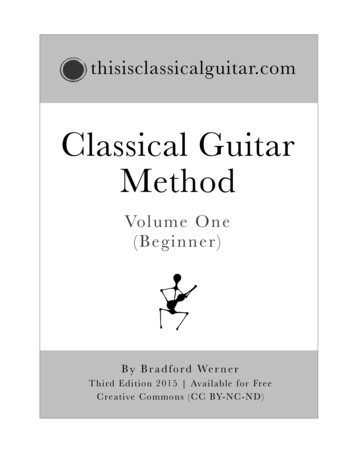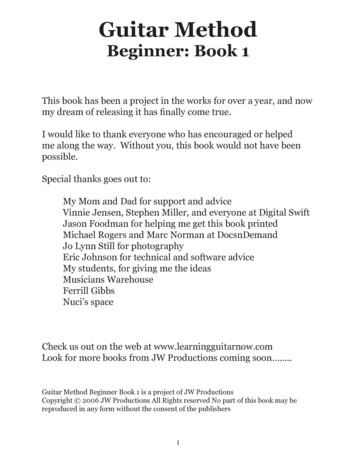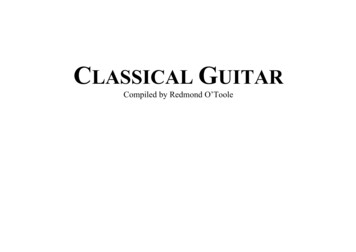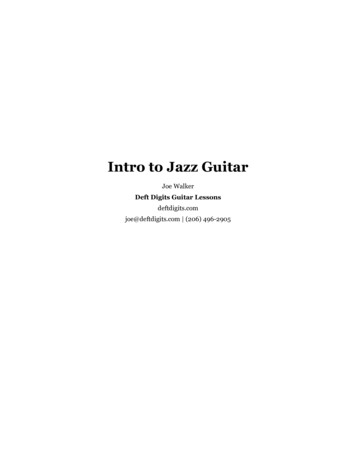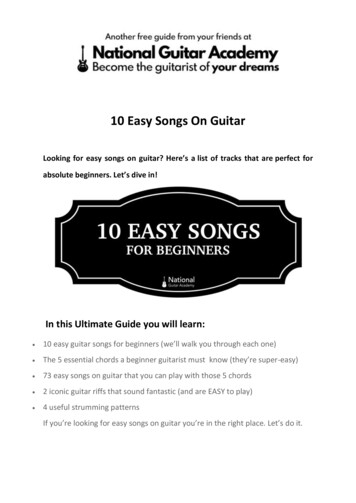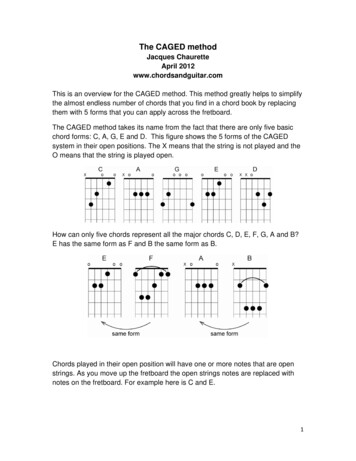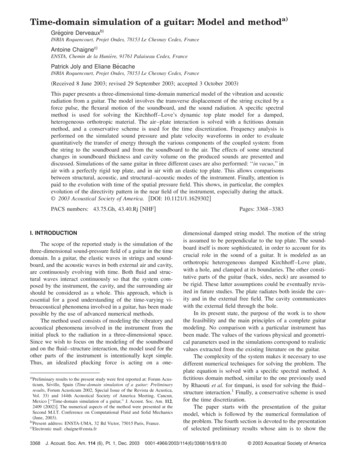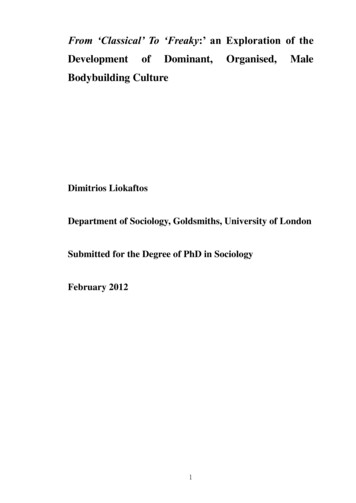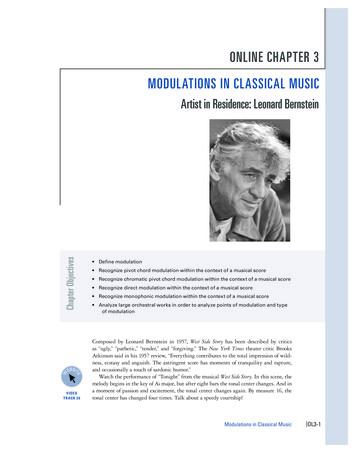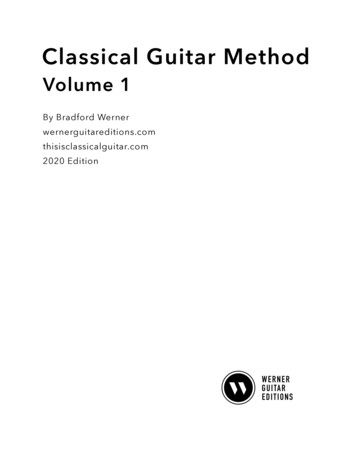
Transcription
Classical Guitar MethodVolume 1By Bradford r.com2020 Edition
Classical Guitar Method - Volume 1by Bradford Werner2020 EditionDistributed m Bradford C. Werner, 2020.All Rights Reserved.Sharing InfoThis work is licensed under the Creative Commons Attribution-NonCommercial-NoDerivatives 4.0International License. You can share this work but must give credit and link to my site. You may not sellthis work, use it for commercial purposes, alter it and/or distribute a modified version.Printing the PDFThis PDF has been designed for double sided printing. Place it in a three ring binder with dividers foreach section. You are not permitted to print and sell this book.Hard CopiesPhysical print editions of this book are available on Amazon Stores online.2
ContentsPart 1 - Progressive Method9Brief Definitions of Music Notation12Three Open Strings, Rhythms, Etude No. 1 and 2, Nocturne Duet17Notes on the Third String, Sight Reading, Moderato, A Fairy Tale Duet21Notes on the First and Second String, Note Review, Sight Reading, Five Melodies26Ode to Joy Duet, Sight Reading and Dynamics, Etude No. 3, Note Review30Twinkle Twinkle Little Star, Etude No. 4, Jazz Cat, Au clair de la lune, Oh Susana35Duets: Waltz by Czerny, Minuet by Wilton, Morning by Diabelli38Open Bass Strings, Etudes No. 5, 6, and 742New Notes (C, D, E, F), Note Review, Etude No. 8, C Major Scale4651Eighth Notes, Sight Reading, Angeline the Baker, Minuet Duet by Hook, Etude No. 9,Vsi so venci Vejli, Flow Gently, Sweet Afton Duet54Two Voice Textures, Etude No. 10 and 1157Dotted Quartet Notes, Little Birch Tree in the Field, The Skye Boat Song60Fifth and Sixth String Notes, Note Review, Sight Reading, Leyenda Theme by Albeniz66Accidentals, Chromatic Scale, Greensleeves, Malagueñas, Minuet in G Duet by Petzold71Siciliano by Carcassi, FarewellPart 2 - Chord & Fingerstyle Accompaniment73Strumming: Hey Ho, Frère Jacques, London Bridge, You Are My Sunshine, AmazingGrace, Red River Valley, Tom Dooley, Danny Boy, Shenandoah, Scarborough Fair84Fingerstyle: Tablature Explanation, Scarborough Fair, Will the Circle Be Unbroken,Saint James Infirmary, House of the Rising Sun88Pentatonic Minor & Blues Scales, Twelve Bar Blues, The Shuffle, Rhythm Riff BluesPart 3 - Technique & Knowledge92Right Hand Technique Routine94Left Hand Technique Routine95Single String Chromatic Scales98Beginner Scales: E Chromatic, C Major, G Major, F Major, A Minor, E Minor, D, MinorAppendix101Basic Note Reference Chart102Chord Reference Chart3
About this bookThis book teaches classical and fingerstyle guitar skills with a focus on the rich pedagogical tradition ofclassical guitar. Most learning objectives are covered through pieces and duets rather than exercises ordescriptions. This allows students to perform full pieces from the first lesson. Working with a qualifiedteacher as well as watching the lesson videos should provide students with a healthy start to guitar.How to use this bookStudy Part 1 in order, covering every piece on every page. Simultaneously begin Part 3 as a techniqueroutine. Part 2 (chords) can be studied more loosely based on the skills and age of the student. Watchthe video lessons to help you learn proper technique, musicality, and listening skills.Free video lessons, an essential part of this methodThe video lessons for this book are essential to the learning experience. Ideas about musicality andtechnique are discussed and demonstrated in the videos. This book omits information that mightclutter the beginner learning experience. Music should be learned through listening and experience.All the extra information and advice has been included in the free lesson videos which is a bettermedium for communicating musical ideas. Find the lessons at the method book page at Werner GuitarEditions or This is Classical Guitar (also via the sheet music page or lesson lassical-guitar-method-book-pdf/Five main goals of this book1.2.3.4.5.Play solos and duets from start to finish with a steady tempoPlay legato melodies (also with open string bass accompaniment)Play arpeggio pieces and patternsBecome proficient at reading music in first position (without key signatures)Accompany basic songs with strumming or fingerstyle chordsEducational Series (Further Study) Method Book Volume 2 - Continue your progress with new repertoire, techniques, keysignatures, scales, time signatures; theory, musicality, rhythm training; new chords and more. Repertoire Lessons Grade 1 to 6 - A dedicated book of lessons and repertoire for each grade.All the pieces come with dedicated lesson pages and video lessons to help you learn. Classical Guitar Technique, Essential Scales, Arpeggios, and Exercises - Routines for alllevels, hundreds of exercises, video lessons.4
Rest stroke or free stroke? Nails?Teachers have different opinions about the use of rest and free strokes for beginners. I have seen goodresults from both approaches. My beginner students use free stroke until proper hand positions and arelaxed legato playing style are established. Students need not introduce right hand nails until handpositions and posture are secure. I introduce rest strokes and nails during my Volume 2 method.Use of the left hand pinky fingerStudents should use the left hand pinky for D and G (3rd fret of the 1st and 2nd strings). This fingeringis required for solo pieces later and helps align the left hand. Students will have no trouble using thepinky if it is curved and in the proper position.Music TheoryI recommend the Berklee Music Theory Book 1 - Intro to theory which also includes an answer key. Youdon’t really need all this theory info yet but if you’re curious this is a good place to start. You can findthe book link on my site or on Amazon here: https://amzn.to/2K1TeHwTuning the guitarStudents should buy a clip-on tuner, I like the D’Addario Micro Tuner: http://amzn.to/2pecdpNTuning by ear to the teacher should begin during the first lesson as well as relative tuning:1. Play the 6th string at the 5th fret and tune the open 5th string to the same pitch.2. Play the 5th string at the 5th fret to tune the open 4th string.3. Play the 4th string at the 5th fret to tune the open 3rd string.4. Play the 3rd string at the 4th fret to tune the open 2nd string.5. Play the 2nd string at the 5th fret to tune the open 1st string.Follow the site for free Free and premium sheet music & tab: wernerguitareditions.com Free video lessons and instructional articles: thisisclassicalguitar.com Join the email newsletter for with lessons, sheet music, pro videos and more. Sign up at the website.5
Practice AdviceHappiness in small goals: Making your practice sessions enjoyable will be key to long-term musicalsuccess and development. When experiencing difficulties, break up the piece or exercise into smallmanageable goals at a speed you can accomplish successfully. Even if you only play a few notes at atime, playing successfully will improve your skills and give you a feeling of accomplishment.Isolate difficulties and solidify strengths: Balance your practice sessions by working on difficulties aswell as maintaining easy material you can play well. Playing at a high quality level as often as possiblewill help develop a solid foundation. Work on your difficulties near the middle of your practice sessionand finish with something you can play well. This will ensure you end with a positive feeling of success.Practicing is Problem Solving: Practicing is different than just playing the guitar. When you practiceyou need to identify problems or elements you wish to improve and solve them immediately. Simplyplaying the guitar will not make you a better musician. If your teacher says you should practice for 30minutes a day, be sure you are actually practicing for 30 minutes not just playing.Combine repetition with thoughtful practice: Although a certain amount of repetition is required toestablish your skills, balance repetition with thoughtful reevaluation. Sometimes, improvement willoccur by reexamining your posture, hand positions, or elements not directly connected to what you arestudying. Having a qualified teacher is very helpful. They can identify problems before you repeat it ahundred times. That said, aim to be mindful at all times about what you are doing.Good days vs bad days: Actually, I don’t believe in good or bad practice days. All days are goodopportunities to practice something. On days when you are having trouble focusing or executingmaterial cleanly, slow down your speed and use a metronome until you are playing well. You may haveto play at half the speed you intended but you can still get in some quality practice.Play slowly: I’ve rarely encountered a student who practices as slowly as I think they should. Practicingultra slowly will ensure you are playing with your best hand positions, sound, confidence, relaxation,accuracy, and more. The majority of your practicing should be at very slow tempos. Once you can playsomething well at a slow tempo, you can speed it up while keeping an eye on the quality level.Page markers: Use page markers (sticky tabs) on the pages you are practicing so you can quickly flipto the next piece or exercise.Keep it simple: Even the most advanced players will practice simple open string exercises but will doso at a very high quality level. Quality practice helps to improve your playing so keep the exercises andpieces simple enough that you can accomplish them at your highest potential. You don’t have to proveyourself to anyone. You‘ll only improve if you set realistic and manageable goals.Trust your teacher: If your teacher recommends something contrary to what’s in this book, please trusttheir advice. Your teacher knows what’s best for you and your personal and unique development.Learning from books and online videos can be helpful but the real work is done through long-termcommunication with teachers and other musicians.6
Getting Started - Finger NamesLeft Hand Finger Names1 index2 middle3 ring4 pinkyRight Hand Finger Namesp thumbi indexm middlea ringc pinkyAnatomy of the Classical GuitarBodyFingerboard & FretsSoundholeRosetteBridgeImage use - By User: Martin Möller (File:Classical Guitar two views.jpg) [CC BY-SA 2.0 e/deed.en)], via Wikimedia Commons7Head& Tuning Pegs
Hand and Sitting Positions for Classical GuitarSee more photos and video lessons on posture and hand positions: thisisclassicalguitar.com/lessons/Sitting Position The head of the guitar is at eye level (guitar is at a 45º angle) Face of guitar straight up and down (not angled back) Sit up straight and relax the shoulders and neckRight Arm & Hand Right forearm rests on the guitar in front of the elbow Right wrist is straight with a relaxed arch Right hand plays around the rosette Right hand fingers move into the palm, not up and away Right hand thumb is in front of the fingersLeft Arm & Hand Left hand thumb is vertical and behind 2nd finger Left palm and knuckles are parallel with the strings Left wrist is straight, not over-extended Left hand fingers are curved and contact the strings on the fingertipsSame position applies toguitar supportsHead of guitar at eyelevel (guitar at 45º angle)8
Beat, Tempo, NotesBefore you begin reading music, review these basic music notation terms and symbols. You can alsosee the article on the website that includes videos to help you get oriented.The beat, also called pulse, is the basic unit of time in a piece of music. For example, if you listen to asong and begin to tap your foot at regular intervals you are likely tapping 'the beat'.The word tempo is used to describe the how fast or slow the beat is moving.Notes are symbols used in music to represent the pitch and rhythm of a standardmusical sound. Pitch refers to how high or low a note sounds. The Rhythm indicateswhen to play a pitch. Anatomy of a note:Noteheads Noteheads with stems Stems with flagsNotes will be placed on a staff (5 lines), as shown below. Bradford Werner, 2020. All Rights Reserved.Sheet Music with Videos: wernerguitareditions.comLessons, Pro Video, & Blog: thisisclassicalguitar.com9
Basic Musical SymbolsThe Staff has five lines.The Treble Clef Sign is used in guitar notation (also called the G Clef). The clef indicates whichnotes are represented by the lines and spaces on a staff. The bottom circular part of the treble clefdesignates the second to bottom line as G. There are other clefs in music, but guitar primarily usesthe treble clef so that's all you need to know for now. A treble clef with an 8 below is often used in guitar notation. Guitar sounds one octave belowwhere it's written (we'll learn more about that later). Bars, also called Measures, are used to divide the staff into sections. Bar lines divide the staff intobars. Double bar lines usually mark the end of a section. Final bar lines mark the end of acomposition (song or piece). Bar line Double bar line Final bar lineThe Time Signature tells you how many beats are in each bar and what type of note equalsone beat. Beginners only need to know about the top number for now. 10 The top number states how many beats are in each bar.The bottom number states the rhythmic value of each beat. Bradford Werner, 2020. All Rights Reserved.Sheet Music with Videos: wernerguitareditions.comLessons, Pro Video, & Blog: thisisclassicalguitar.com
Notes & RhythmsThe below staff shows standard music notation starting on the lowest note of the guitar. The linesabove and below the staff are called Ledger Lines which extend the range of the staff. Notice howthe note names go up in the order of the musical alphabet: A - B - C - D - E - F - G and then repeat ata higher pitch. There are actually twelve notes in the musical alphabet but we'll learn a
The head of the guitar is at eye level (guitar is at a 45º angle) Face of guitar straight up and down (not angled back) Sit up straight and relax the shoulders and neck Right Arm & Hand Right forearm
